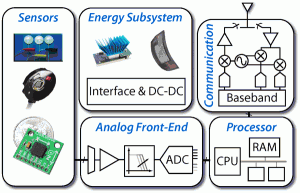An Energy-efficient Biomedical Signal Processing Platform
Advances in mobile electronics are fueling new possibilities in medical monitoring in which sophisticated, wearable devices can monitor a subject’s vital signs. In these applications, comfort and convenience are important considerations, motivating a high level of integration to achieve small form factors and long operating lifetimes from a small battery or scavenged energy. Fortunately, the low rates of biological signals, which are typically on the order of tens to hundreds of Hz, make basic monitoring applications amenable to low-power processing [1] [2]. To support the wide range of signals, sensors, and algorithms, we propose a flexible and energy-efficient signal processor for medical monitoring.
The processor is intended as part of a body-worn sensor node pictured in Figure 1. In this context, the processor can analyze the physiologic data in real time and extract key features for transmission or storage. In the processor design, we explore the addition of custom hardware accelerators to reduce the cycle count and energy for common tasks [3]. Improvements to classic architectures are proposed to reduce power and improve versatility. On the system level, the key strategy to improve energy efficiency is to aggressively scale the power supply voltage according to application performance demands [4]. However, increased sensitivity to variation at low voltages must be mitigated. Accordingly, this work presents a design flow and hold-time verification methodology to address local variation.
The above techniques are demonstrated in a biomedical signal processing platform in 0.13-µm CMOS. Preliminary test results show that the custom accelerators enable substantial energy savings in benchmark biomedical applications.
References
- A.P. Chandrakasan, N. Verma, and D.C. Daly, “Ultralow-Power Electronics for Biomedical Applications,” Annual Review of Biomedical Engineering, vol. 10, pp. 247-274, Aug, 2008. [↩]
- A.C.-W. Wong, D. McDonagh, G. Kathiresan, et al., “A 1V, Micropower System-On-Chip for Vital-Sign Monitoring in Wireless Body Sensor Networks,” IEEE International Solid-State Circuits Conference, Feb. 2008, pp. 138-139. [↩]
- N. Ickes, D. Finchelstein, and A.P. Chandrakasan, “A 10-pJ/instruction, 4-MIPS micropower DSP for sensor applications,” in IEEE Asian Solid-State Circuits Conference, Nov. 2008, pp. 289-292. [↩]
- A. Wang, A. Chandrakasan, and S. Kosonocky, “Optimal supply and threshold scaling for sub-threshold CMOS circuits,” in IEEE Computer Society Annual Symposium on VLSI, Apr. 2002, pp. 5-9. [↩]
